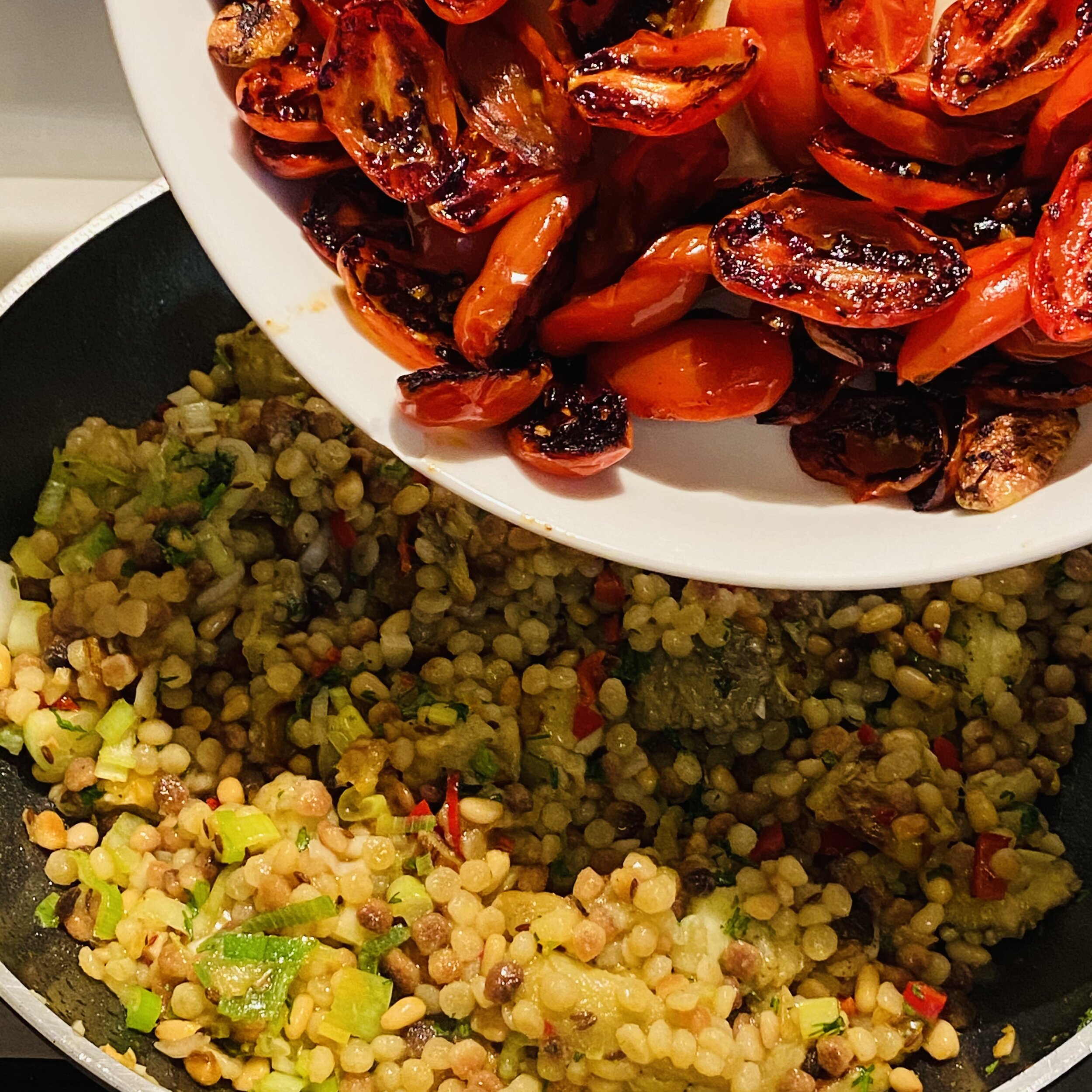Who knows why we are drawn to the mouthfeel of certain pasta shapes over others. After all, the common denominator is a simple combination of flour and water with the occasional egg - that really is the long and the short of it (pasta pun). Some are tightly tethered to tradition - think bucatini and amatriciana - while others flirt brazenly with innovation.
Fregula is one of the latter, adapting readily to creative whims and crossover proposals. This flexibility has kept it from stagnating as a regional curiosity and ingratiated it into the modern kitchen. Not so long ago, you had to go to Sardinia if you wanted fregula. Holiday-makers returning from their summer sojourn to the island would bring it back as a souvenir gift for their plebeian friends, and so my pantry was often graced with a pack or two. Now it is in the pasta aisle of every Italian supermarket, and I imagine, too, that its a desideratum in shi-shi shops abroad catering to the discerning consumer. However, as far as I know, fregula has not yet achieved the status whereby it is being manufactured in multicolors.
Making fregula by hand is by no means the apogee of every pasta enthusiast, like orecchiette or corzetti are these days. But I was psyched for the full immersion experience and spent some time learning to make this small Sardinian form at home. The basic concept is not difficult to grasp. It is very much like couscous, but larger. In fact, the final product is nearly identical to what is called Israeli, giant or pearl couscous.
The pearl image is quite appropriate because you start with a small amount of coarse semolina in the bottom of a wide, shallow terracotta container as instigators and, with open fingers moving in steady circles along the base, you keep the grains in constant motion, all the while slowly adding a dusting of fine semolina and a few drops of water, and more fine semolina and more water. Achieving the right balance of ingredients and movement requires experience and technique, but with patience and perseverance, even your first attempt should produce encouraging, edible results.
Women who are very adept end up with a slew of tiny balls of fregula that are nearly uniform in shape and size. The pasta is dried in the sun and then baked for a few minutes to ensure that it has dried completely.
My level of expertise is nothing to write home about as yet, so this recipe was developed with store-bought fregula. Best practice when purchasing: get one with a granular surface that shows clear signs of having been baked.
Working out a recipe
Despite current availability, the potential of these lentil sized granules is yet untapped, and that is where I have come to make my mark. The driving inspiration for this dish was to create something summery that pushed this Sardinian specialty towards modern Middle Eastern cookery and flavors. My original thought was to stuff tomatoes with a fregula/eggplant stuffing, but I would rather wait until tomatoes peak if they are going to play a lead role. So, I opted for eggplant stuffed with fregola and grape tomatoes. Eggplant are good year round here, and hothouse grape tomatoes have become consistently sweet and flavorful; when they are flash caramelized, it adds a deeper dimension to the taste.
The filling base is heightened with the distinct aromatics of cilantro and cumin, both of which move the dish away from standard Italian culinary grammar and take it eastward. That combination is punctuated further with lightly sautéed fresh red chili pepper and spring onion, a generous amount of garlic and the toasty taste of browned pine nuts.
SPICY FREGULA STUFFED EGGPLANT
INGREDIENTS:
serves 2-4
4 firm medium eggplants
150g fregula
4 cloves garlic
olive oil (as indicated)
250g fresh grape tomatoes (datterini) sliced in half
50g pine nuts
1 tsp cumin seeds
1 fresh red chili, chopped
1-2 green onions, chopped
1 large handful coriander leaf, chopped
salt
INSTRUCTIONS:
Preheat the oven to 180°C.
Cut the eggplant in half and score diagonally as shown. Pour about 2 tablespoons of olive oil on each half.
Place scored side down in a non-stick baking dish and bake for 30 minutes until soft but not excessively mushy.
For the filling:
Boil the fregula in a small saucepan with a good dosing of salt. It should be like a salty broth - edible but pretty salty. Cook the fregula for about 10 minutes. Remove with a slotted spoon. Set aside.
Smash one garlic clove under the flat side of a large knife. Remove the skin and place in a skillet with two tablespoons of olive oil. When it starts sizzling, add all of the tomatoes cut side down so that each is directly in contact with the surface of the pan.
Cook on high until they begin to caramelize and brown. Do not stir or toss. Set aside in a bowl when they are cooked. Avoid fussing with them too much so that they stay intact.
Heat 2 tablespoons of olive oil in a skillet. Chop the remaining garlic and add it to the skillet with pine nuts and cumin seeds. Once the pine nuts start to brown, add the onion and chili. Sauté one minute.
Carefully scoop out the eggplant pulp making sure not to dig too deeply - the shells need to maintain their shape - and try to keep the eggplant bits chunky. Add the coriander, onion and fregula. Toss on high heat one minute until combined. Lastly, off heat, stir in the tomatoes.
Stuff the eggplant shells with the prepared filling. These can be enjoyed as is or made up ahead and eaten at room temperature. It is also possible to store the filling in the refrigerator and stuff the eggplant before serving.
One of these halves with a side salad or vegetable makes a full meal.
If I pace myself, I can get two halves down. Plan accordingly.

















